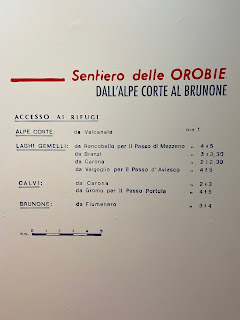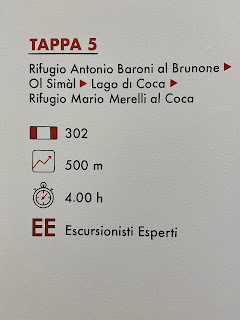In this installment of Street Sign Language Lesson, we are in Porto Venere, a beautiful seaside town in Liguria. As we promenaded up and down the lungomare, we saw a number of interesting words and language lessons. We'll learn about aperifritto, testaroli, and the mysterious acronym RNM. For more information and photos from a week in Porto Venere, see the post A week Porto Venere, Liguria – Life along the lungomare.
 Aperifritto Small appetizers of fried things that, together, could be eaten instead of a full mealAperifritto
Aperifritto Small appetizers of fried things that, together, could be eaten instead of a full mealAperifritto is a
portmanteau (in Italian referred to a
parola macedonia), that is a blend of two words, in this case
aperitivo and
fritto. The Accademia della Crusca
has an article about
apericena and related words like
aperifritto. In Liguria, fried fish are a common item on menus and as fast food.
 Area interdetta alla balneazione
Area interdetta alla balneazione
Area closed to bathing. Or, no-bathing areaIt's just us, but the word
balneazione (and related ones like
balneare,
balneabile) is weird looking. We realized it's from Latin
balneum – bath, bathing place, bathroom. Maybe we should have studied Latin and it wouldn't be so strange.
 Stabilimento balneareBeach resource or beach club
Stabilimento balneareBeach resource or beach club In an area like Porto Venere, you quickly learn which beaches are free and which are private. The private beaches are usually marked as shown in this sign.
Lido is more or less a synonym of
stabilimento balneare. In this beach club, you rent a
lettino (a lounge chair) for 14 euros and an
ombrellone (beach umbrella with lounge chair) for 18 for the entire day. That may seem like a lot but there are usually other services that come with that price like use of the pool, lifeguard, and free WIFI.
 Bagnino
BagninoLifeguard
This sign was see at the Sporting Beach along the lungomare of Porto Venere. It's also in German, bademeister. If you like to have a lifeguard around when you or your family swim, then a stabilimento balneare is for you.
 Domande ricorrentiFrequently asked questions
Domande ricorrentiFrequently asked questions We saw this sign in a shop in Porto Venere selling pesto called
La Bottega del Pesto. The questions are "LO FATE VOI?" – "Do you make it?"; "C'È L'AGLIO?" – "It there garlic?"; "CE L'AVETE ANCHE SENZ'AGLIO?" – "Do you have it without garlic?"; "QUANTO DURA?" – "How long does it last"; "PUÒ STARE FUORI DAL FRIGO?" – "Can it stay outside the refrigerator?" The answer to these questions are yes, yes, yes, 3 months, and 3 days. (Why in the world would you get this without garlic!? 😉)
Note the use of
Lo Stampatello in the sign.
 Il testarolo di PontremoliTestarolo of Pontremoli Testaroli
Il testarolo di PontremoliTestarolo of Pontremoli Testaroli are a pasta – almost like pieces of crepe – based on flour, salt, and water.
Testaroli are cooked on a flat terra cotta or cast iron cooking surface called a
testo. The cooked pasta is sliced into triangular shapes and served with a sauce, like pesto. It is said that
testaroli is an ancient pasta originating from the Etruscan civilization of Italy.
Testaroli are common in the
Lunigiana region, an historical territory of Italy, that today is centered around Pontremoli, and included parts of the Province of Massa Carrara (Tuscany) and the Province of La Spezia (Liguria). Porto Venere is in the Province of La Spezia.
 Le insalatoneMixed salads
Le insalatoneMixed salads I saw this and immediately thought "ah ha" it should be
le insalatoni with an I. In Italian, the
augmentative (called the
accrescitivo) of feminine nouns is such that they usually become masculine in gender when adding
-one. Examples for nouns include:
porta =>
portone,
donna =>
donnone,
barca =>
barcone,
testa =>
testone,
scatola =>
scatolone,
scarpa =>
scarpone,
maglia =>
maglione, etc.
But, there are some examples of feminine nouns not changing gender, including
sudicia =>
sudiciona and
insalata =>
insalatona. And,
insalatona is more than just a big salad, it's an abundant mixed salad.
But there's more. In some cases, some claim there are shades of meaning whether the augmentative is masculine or feminine. For example, you could say
donnone – a very large woman conjuring something monstrous and without grace, or
donnona – a very large woman, but still with grace and femininity. See this
thread.
 RNM – resti non mineralizzatiThe remains of the body are not fully decomposed to just bones.
RNM – resti non mineralizzatiThe remains of the body are not fully decomposed to just bones.
We saw this designation on recently burial mounds in the ground. (Yeah, we spend time in cemeteries.) See the post
A Week in Porto Venere: RNM for more of explanation, but essentially, space must be managed in cemeteries with limited amounts of it. One way to do that is to exhume the remains of a burial concession (think niche, crypt) that have had lapsed payment. If no one steps up to pay, the remains are consigned to a communal ossuary. However, if the remains aren't finished decomposing, they will be put in the ground for some time to help that process. RNM means the grave contains remains exhumed that weren't finished turning to bone.

































































